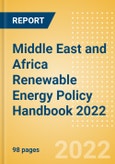"Middle East and Africa Renewable Energy Policy Handbook 2022” is among the latest region specific policy reports from the publisher. The report covers 16 major countries in the Middle East and Africa region:Algeria, Angola, Egypt, Ghana, Iran, Israel, Kenya, Kuwait, Morocco, Mozambique, Nigeria, Qatar, Saudi Arabia, South Africa, Tanzania, and the United Arab Emirates. The report offers comprehensive information on major policies governing the renewable energy market in these countries.
The report discusses renewable energy targets and plans along with the present policy framework, giving a fair idea of overall growth potential of the renewable energy industry. The report also provides major technology specific policies and incentives provided by the countries in the region.
The report is built using data and information sourced from industry associations, government websites, and statutory bodies. The information is also sourced through other secondary research sources such as industry and trade magazines.
The report discusses renewable energy targets and plans along with the present policy framework, giving a fair idea of overall growth potential of the renewable energy industry. The report also provides major technology specific policies and incentives provided by the countries in the region.
The report is built using data and information sourced from industry associations, government websites, and statutory bodies. The information is also sourced through other secondary research sources such as industry and trade magazines.
Scope
- The report covers policy measures and incentives used by countries in the Middle East and Africa region to promote renewable energy.
- The report details promotional measures in the Middle East and Africa region both for the overall renewable energy industry and for specific renewable energy technologies that have potential in the region.
- The report covers 16 major countries in the Middle East and Africa region:Algeria, Angola, Egypt, Ghana, Iran, Israel, Kenya, Kuwait, Morocco, Mozambique, Nigeria, Qatar, Saudi Arabia, South Africa, Tanzania, and the United Arab Emirates.
Reasons to Buy
The report will enhance your decision making capability in a more rapid and time sensitive manner. It will allow you to:
- Develop business strategies with the help of specific insights about policy decisions being taken for different renewable energy sources.
- Identify opportunities and challenges in exploiting various renewable technologies.
- Compare the level of support provided to different renewable energy technologies in different countries in the region.
- Be ahead of competition by keeping yourself abreast of all the latest policy changes.
Table of Contents
1 Executive Summary5 Ghana Power Market, Regulatory Scenario6 Iran Power Market, Regulatory Scenario7 Israel Power Market, Regulatory Scenario8 Kenya Power Market, Regulatory Scenario9 Kuwait Power Market, Regulatory Scenario10 Morocco Power Market, Regulatory Scenario11 Mozambique Power Market, Regulatory Scenario12 Nigeria Power Market, Regulatory Scenario13 Qatar Power Market, Regulatory Scenario14 Saudi Arabia Power Market, Regulatory Scenario15 South Africa Power Market, Regulatory Scenario16 Tanzania Power Market, Regulatory Scenario17 UAE Power Market, Regulatory Scenario18 Appendix
2 Algeria Power Market, Regulatory Scenario
3 Angola Power Market, Regulatory Scenario
4 Egypt Power Market, Regulatory Scenario
List of Tables








